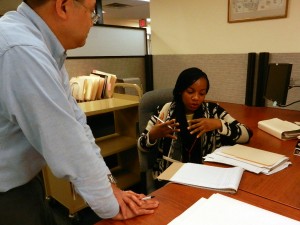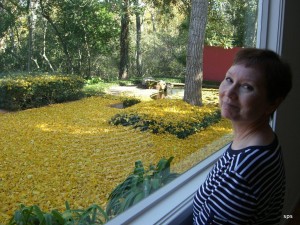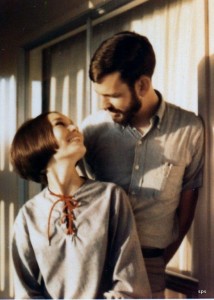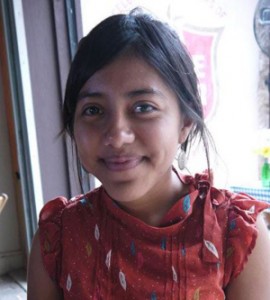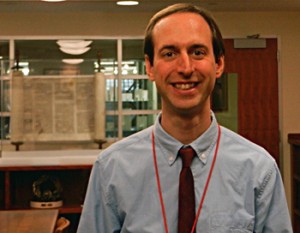
Chinwendu Rose Ejezie recently joined our team here in Special Collections as our new Shuart Women’s Archive Graduate Assistant. Earning her Bachelor of Arts in English and Literary Studies from the University of Port Harcourt, Nigeria, Ms. Ejezie began her graduate study in the fall of 2013, pursuing her Master of Science in Human Resource Development through the College of Technology here at the University of Houston.
Thanks in large part to the generous support of Mr. Jeff Beauchamp and the Friends of Women’s Studies, the Shuart Women’s Archive is able to apply the talents of Ms. Ejezie to the surveying, arrangement, and description of new and unprocessed collections with particular regional and national research potential. Ms. Ejezie began her work here in Special Collections in mid-February 2014 and has hit the ground running, working with the recently acquired Toni Beauchamp Papers.
By her own account, Ms. Ejezie has been impressed with the depth and content of the character of the late Toni Beauchamp as she reviews her papers. At first tentative and fighting back the feelings of invading one’s privacy that come with the territory of the archives, Rose has quickly discovered the passion Ms. Beauchamp had for the altruistic work being done and the people that made the work possible, noting that this dedication shines through in the collection, even as it is being processed.
Previous work in the Architecture and Art Library gave Ms. Ejezie an understanding of the amount of work going on behind the scenes to make research available to the general public, but now she has taken on a role in the vanguard as she prepares collections for future research. Settling into this new role in Special Collections, Ms. Ejezie has been quick to point out the supportive environment provided by Vince Lee, Archivist for the Carey C. Shuart Women’s Archive & Research Collection, and others as she immerses herself in this new world of the archives. She hopes the insight gleaned from working in this capacity will help translate to future work in human resources, the handling of sensitive documents, confidential information and the like.
Ms. Ejezie is slated to graduate in December 2015. However, hailing from a family that embraces and values education, she is weighing her options of pursuing further studies or beginning a career track in human resources. Until then, Special Collections is thrilled to have her talents and insights as we continue to grow our collections.
Archivist Vince Lee of the Carey C. Shuart Women’s Archive and Research Collection will showcase artifacts from the recently acquired Toni Beauchamp Papers at Table Talk 2014, presented by the University of Houston Friends of Women’s Studies on Thursday, February 27th.
Defining Toni Beauchamp’s legacy in Houston is an exciting challenge. The term “patron” was often applied to her during her lifetime and certainly remains today. However, her involvement with art went beyond mere patronage, and we may find that word to be too narrow, now. The role of art was exemplified into two spheres in her life, civic duty and personal advocacy. Her involvement and leadership on such public projects involving the renovation of Buffalo Bayou and Market Square Park fulfilled a vision that art, thoughtfully integrated with urban design, results in beautification, preservation, and forging an identity for the community. Art was also very personal for Toni. Art provided her a means to shape and influence the community, forge friendships, and most importantly it was an opportunity for her to educate and share information with others.
Her connection to the University of Houston dates back to 1973, when she earned her BA in Art and where she would later serve as assistant director of the Blaffer Gallery. The acquisition of her papers, thanks to the generosity of her husband Jeff Beauchamp, has us very excited to begin the work of processing, arranging, and making these materials available for study to scholars both local and abroad. These papers complement other offerings in Special Collections like her collection of essays, Good, and “Remembrances of Toni” (a collection of reflections on Toni’s life) compiled by her husband Jeff. The spirit and legacy of Beauchamp make her papers a natural fit amongst the other bold women at the vanguard, whose collections grace the stacks of the Shuart Women’s Archive.
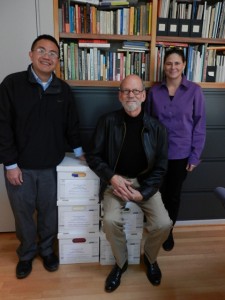
Archivist Vince Lee, Jeff Beauchamp, and personal assistant Kim Pence, overseeing the transfer of the Toni Beauchamp Papers
At Table Talk 2014 Vince Lee will have artifacts from Toni Beauchamp’s work on Good, as well as her involvement with the “Buffalo Bayou Master Plan” and “Market Square Park Project.” Friends of Women Studies hosts the annual Table Talk series, “a fascinating combination of conversations over lunch, led by dynamic women of various cultures, professions and experience at each table,” benefiting Women’s, Gender & Sexuality Studies at the University of Houston. A list of Conversationalists attending this 17th annual Table Talk can be found here.
Time permitting, be sure to attend Table Talk 2014 and visit with Vince Lee for more information regarding the legacy of Toni Beauchamp, the research potential her papers will offer, and their new home in the Carey C. Shuart Women’s Archive and Research Collection.
The following comes to us courtesy of Ryder Kouba, exiting University Archives Fellow here at the University of Houston Special Collections. After a year and a half of service to the University, Ryder has accepted the position of Digital Collections Archivist in the University Archives at the American University in Cairo. We wish Ryder all of our best!
In August 2012 I joined the staff of Special Collections as the University Archives Fellow. Fresh out of the University of Texas’ School of Information, I was excited to return to my hometown of Houston to help preserve and make accessible the unique history of UH. Working at UH for the past 18 months has been a very rewarding experience, both professionally and personally.
My tenure began with a fun project documenting the history of the venerable Robertson Stadium before it was torn down in the fall of 2012. To create an exhibit covering the multiple uses of Robertson over the years required background research into notable events, what materials we had in our collections, and reaching out to departments around campus and individuals in the community.
A focus of my time was creating policies and procedures for the University Archives and Special Collections with Mary Manning, the University Archivist. An important aspect of documenting the university’s history is acquiring the appropriate materials; to that end Mary and I created transfer policies and guidelines for departments on campus as well as for private individuals, such as alumni. Standardizing these processes will allow Mary to acquire materials more efficiently from a wide variety of organizations and people.
Establishing guidelines for accessioning born-digital materials was the largest project I worked on, and I feel like the most valuable. When I arrived the University Archives had over 600 CDs, which as anyone who has scratched one can attest, are not the most durable of media. Creating policies and procedures from scratch was an intensive process of researching the fundamentals of preserving born digital materials (which UT had given me a solid foundation in) and seeing what other institutions were doing. After much work fine tuning our procedures, experimenting with software, and sharing it with fellow staff members, I’m happy to report that most of the 600+ CDs have been moved to storage on our servers.
I have been lucky that UH has been very supportive in my professional development; I’ve been able to attend conferences and workshops, particularly regarding digital practices, and bring my newfound knowledge back to UH. I was also able to present a case study of our development of policies and procedures at the Society of Southwest Archivists conference in 2013.
The end of my time at UH began as it started; working on an exhibit that Mary is putting together showcasing the history of Frontier Fiesta, one of UH’s most notable traditions. Overall, it’s been a wonderful year and a half for me, and Special Collections as well. I’ve provided professional level staffing to process university records, create policies and procedures, and showcase university archives holdings through exhibits. I have also been able to serve the entire library through committee work and serve both the university and community through providing reference services and outreach.
I will miss my colleagues in both Special Collections and M. D. Anderson Library and look forward to hearing about the exciting growth of the library and university in the coming years.
In lead up to the premiere of “The Rise and Fall of Penn Station” this evening on PBS (9pm/8pm CST), American Experience has been soliciting contributions to its Engineering Map of America. A number of academic institutions have partnered with American Experience to assemble an interactive map of some of America’s greatest engineering endeavors. Valerie Prilop, our Digital Collections Librarian, has contributed a number of resources from the University of Houston Special Collections. Today, we highlight a few of these.
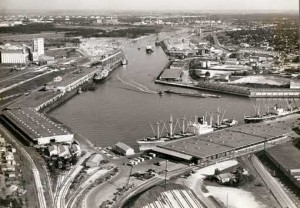
Houston Ship Channel, Turning Basin, from the James H. Branard Jr. Port of Houston Collection, University of Houston Libraries’ Special Collections
The Houston Ship Channel: The Houston Ship Channel is a man-made channel for ocean-going ships that supports the Port of Houston, the nation’s busiest port in terms of foreign tonnage and the second largest petrochemical complex in the world. The channel, which officially opened on November 10, 1914, after its completion on September 7 of that year, was originally a swampy bayou and surrounding marshland with dense vegetation. Steamboats and shallow draft boats were the only vessels that could navigate the waterway and the dredging and deepening of the channel contributed greatly to the growth of Houston and Texas.
Even after its official opening, the channel continued to be widened and deepened. It now measures 45-feet deep and runs up to 530 feet in width. The entire channel stretches 52 miles from the Gulf of Mexico through Galveston Bay and up the San Jacinto River, ending less than 10 miles east of downtown Houston at the Turning Basin.

Astrodome, from the Elizabeth D. Rockwell Papers, University of Houston Libraries’ Special Collections
The Astrodome: Upon its completion in 1964, the Reliant Astrodome was the world’s first completely enclosed stadium, the first air conditioned stadium, and the largest domed structure, and when it opened as the Harris County Domed Stadium in April 1965 it was called the Eighth Wonder of the World. A major engineering challenge was how to span 642 feet, an unusually large area for a roof structure, without interior supports. The final design used a steel lamella trussed roof structure. The resulting 660-foot-wide circular roof was at the time of completion the largest self-supporting dome.
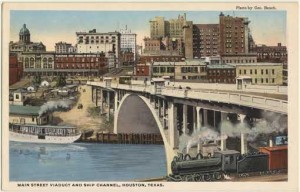
Main Street Viaduct, from the George Fuermann “Texas and Houston” Collection, University of Houston Libraries’ Special Collections
The Main Street Viaduct: From the time of its founding, Houston relied on bridges for connecting the city and allowing commerce to flourish. Buffalo Bayou, upon which the city was founded, presented a major challenge to mobility as it separated the north and south ends of the city. To answer this problem, planning started in 1911 to build a monumental bridge across Buffalo Bayou. An extension of Main Street, the bridge was to extend 1,650 feet across the water. When it was completed in 1913, the Main Street Viaduct was the largest single-arch concrete span in Texas, with the central arch measuring 150 feet. The cost of construction was a half a million dollars, and the bridge was high enough to allow for several railroad tracks to pass underneath.
View all of these and more on the Engineering Map of America!
There has been a lot of excitement back in the Special Collection offices as of late as we have two new additions on our team.
We are very pleased to be bringing in Lisa Cruces, who officially joined us last week, as the new Hispanic Collections Archivist. As Esmeralda Fisher initially reported back in December, the addition of Cruces will have our Hispanic Collections poised for the future in an exciting and emerging area of research. Lisa comes to us from the University of Notre Dame, Hesburgh Libraries where she served as Librarian-in-Residence since July 2012. She has been appointed Member of the Pinkett Award Committee (SAA), served multiple appointments on the Archivists and Archives of Color Roundtable (SAA), and has served as Chair of the Scholarship Committee for the Society of Indiana Archivists. Lisa earned her MSIS from the University of Texas at Austin in 2012.
Matt Richardson joined our team at the end of January to assist archivists with the accessioning of born-digital materials in our various collections and to manage our online finding aids. In this regard, it should be noted that the University of Houston Special Collections is a charter member of ArchivesSpace (a new, open source archives information management application) and our own Mary Manning (University Archivist) has been appointed to its User Advisory Council for a two-year term. Matt will work with Mary and the rest of Special Collections as we transition from one finding aid tool and begin breaking new ground for researchers with ArchivesSpace. Matt earned his Bachelor of Arts and Master of Liberal Studies from Northwestern University where he also cut his teeth in the Preservation Department at the Northwestern University Library.
If you’re visiting us and you happen to see Lisa or Matt, please let them know how excited we are to have them at the University of Houston!
